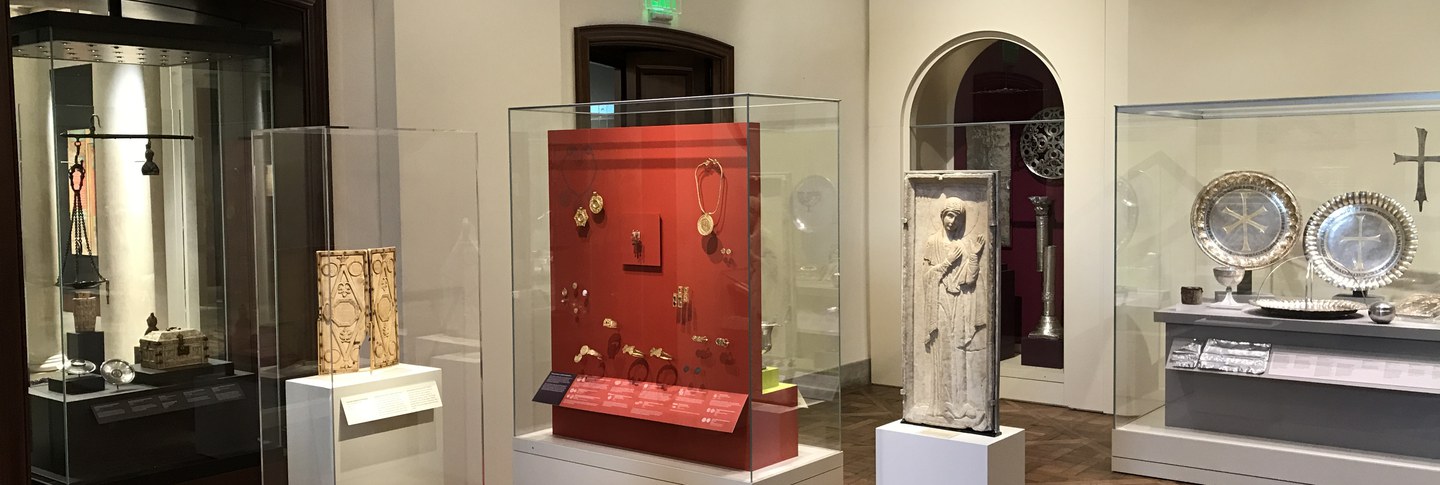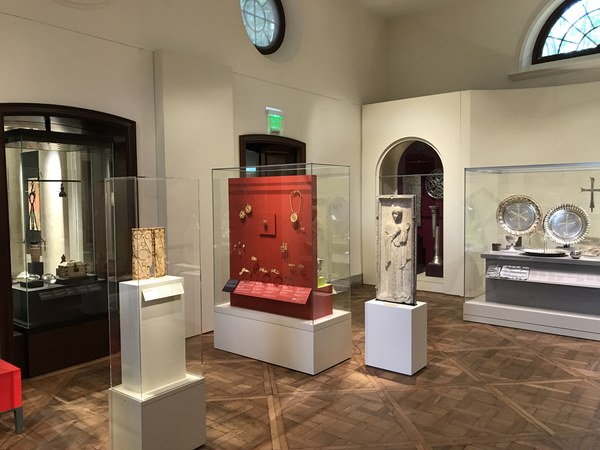The Byzantine Gallery was designed by Thomas T. Waterman beginning in 1938 and opened in 1940.

Understanding the Gallery: Themes
Bringing the Liturgy to Life: Living with the Sacred
Several cases bring Byzantine liturgical practice to life. Two cases containing ecclesiastical silver (the “Riha Hoard”), patens, lamps, gilded book covers, and an incense burner evoke the sensory richness of the Eucharist. These flank a sixth-century Byzantine altar, which was recreated using objects from the museum’s Sion Silver collection. A case containing a Carolingian chalice and Spanish relief lend additional depth to our understanding of ecclesiastical practice by highlighting the contrast among contemporaneous artistic traditions in Western Europe and Byzantium during this time.
Two free-standing panel carvings evoke the sense of a sacralized space. The first, an early Byzantine chancel panel, shows on one side the Sepulcher of Christ. Its back is carved with the image of a large amphora, no doubt alluding to the wine of the Eucharist. The second sculpture is an early Byzantine chancel panel, decorated with geometric patterns on one side. On the other is an image or the Virgin, known in Byzantine culture as the Mother of God. In Byzantium, there was no more compassionate saint than Mary, and her image was believed to be a powerful conduit to a blessed afterlife in paradise.
Another case in this area focuses on illumination. Whether for the liturgy or for personal devotion, lavishly illuminated or punctuated by only a few images, medieval books were elaborate productions that involved the preparation of parchment, the laying out of pages for text and pictures, the mixing of colors, the preliminary drawing and painting of the miniatures, and often the application of gold foil. These illuminated books served both in more public capacities as well as for personal prayer and reflection. The hanging and standing lamps would have shed light on the religious books with their sacred words and holy pictures and serve to evoke the original context in which these books were used.
A case of silver serving vessels, utensils, and other objects that would have adorned the tables in wealthy households provides an interesting contrast to the liturgical silver displayed around it. Elevated status in the Byzantine world was signaled in a variety of ways, including by displaying valuable furnishings within one’s home. These objects also provide glimpses into the secular realm of Byzantium, where mythical references and pagan stories still found expression, despite the increasing Christianization of the populace.
Signaling Status: Personal Adornment
Several cases explore the subject of personal adornment. Jewelry and other luxury items worn and used by members of Byzantine society encoded complex messages about the wearer’s social status, wealth, piety, and political and religious connections. Gold, silver, pearls, and precious gemstones were not only considered beautiful, but also signaled a wearer’s understanding of esoteric decorative motifs, as well as his or her access to valuable materials and the elite artists that crafted them.
A case that punctuates the wall between the Courtyard and Byzantine Galleries provides an introduction to these ideas by addressing concepts of value. The silver plates, amethyst necklaces, and ivory boxes reflect the luxurious appointments of the upper class. Notably, in the Byzantine world, the value of an object was not simply determined by the artistic skill with which it was made, but by its weight. This case, therefore, also displays a steelyard, a mechanism that used counterpoise weights to weigh diverse materials, from gemstones to animal hides. These notions of value would have been highly visible in the kinds of objects displayed by wealthy homeowners, both to decorate their homes and to adorn their own bodies.
Another case focuses on secular adornment, displaying jewelry from the early and middle Byzantine periods. There is a rare early Byzantine marriage belt and a series of marriage rings that appear to have been used in marriage rites. A unique necklace with a diminutive golden Venus standing inside a carved lapis lazuli shell reveals the taste for rare stones and pagan mythology in what must have been, by the time this necklace was made in the seventh century, a thoroughly Christian society.
Two cases center on religious iconography. The cross, an extremely widespread symbol in the Byzantine world, provides the focus of one case, which contains jewelry, crosses used in church ceremonies, and reliquaries. A second case centers on the diverse range of religious symbols, saints, and inscriptions that were applied to rings, pendants, and personal reliquaries in Byzantium. Miniature icons in amethyst, rock crystal, and bloodstone, believed to provide contact with the numinous powers of the holy world of the saints, simultaneously served as public expressions of faithful piety. These rings, pendants, and necklaces were also believed to protect their wearers against spiritual and physical evils.
Signaling Status: Imperial Imaging
From the Late Roman period into the Byzantine era, items of personal adornment also commonly displayed imperial insignia. Four gold pendants and a pair of gold armlets on display, for instance, incorporate imperial coins. These were likely given by the emperor to favored subjects and were worn by the latter as expressions of honor and high status. In the extremely stratified societies of the Roman and Byzantine worlds such valuable gifts would have announced, if not elevated, the owner's status.
Ivory writing tablets gifted by consuls to high officials and aristocrats carry similar messages. Presented as a means of commemorating the beginning of a term of service or to celebrate events in the life of the emperor, these would have declared the favored status and elevated position of the owner.
This section of the Gallery is dominated by a round relief depicting an emperor in full regalia. This image is echoed by smaller imperial portraits on coins, which circulated throughout the Byzantine Empire and beyond, a constant reminder in miniature of God’s regent on earth. A carved ivory relief displayed next to these coins illustrates the close relationship between the emperor and the church by showing a crowned ruler at the intersection of the arms of a large, jeweled cross.
Icons: Communing with the Divine
This section of the Byzantine Gallery displays a diverse assortment of icons (images of Christ and the saints), which were used in both public and personal contexts to forge pathways of communication between people on earth and the divine realm. The veneration of icons provided the Orthodox believer a means of accessing the spiritual world outside of the liturgy. From the life-sized to the miniature, icons were considered powerful images, divine conduits for those seeking spiritual aid and communion with the divine.
These displays also serve to showcase the diversity of icons represented in the museum’s collection. These icons range from relatively common painted panels, to ivory icons, to exceedingly rare miniature mosaics. The juxtaposition of two representations of the Forty Martyrs of Sebasteia, one a fourteenth-century miniature mosaic from Constantinople and the other a seventeenth-century painted triptych from Greece, illustrates the strength of the artistic tradition of Orthodox Christian art through the centuries.
Death and Pilgrimage
Burial marked the end of one life and the beginning of another. This section of the Gallery focuses on funerary art as well as practices of visitation and pilgrimage, which frequently centered on the visitation of the holy dead, such as Christ and the saints.
Ranging from the Roman through the medieval periods, these objects represent different cultures of the Mediterranean world, much of which moved in and out of Byzantine control over the centuries. Two particularly unusual objects include an exquisitely painted mummy portrait from Egypt and a lead coffin from the Syro-Palestinian region. The Roman world is represented by a fragment of an early Christian sarcophagus as well as by the impressive Seasons Sarcophagus, a late pagan marble coffin with figures of the four seasons flanking portraits of a deceased couple within a zodiac ring. Several fragmentary reliefs from mortuary buildings decorate the walls, evoking the architectural spaces and mortuary monuments that would have originally surrounded these objects.
A case at this end of the Byzantine Gallery expands ideas of the funerary and mortuary to include the visitation of the dead. Rites of commemoration involved censing, illuminating, and leaving offerings within the burial chapels or catacombs in which the dead were interred, with images of the dead themselves often overseeing these events.
The most frequently visited dead, of course, were saints and martyrs. Faithful pilgrims would travel long distances to holy sites. There, they would often view the saint’s or martyr’s remains in the form of a reliquary. As was likely the case for the fragmentary reliquary displayed here, oil would have been poured into the casket, draining out of a hole to be bottled in small flasks. Having touched the sacred remains within the reliquary, this oil was considered spiritually potent and was sold to visiting pilgrims. The inscription of the lead flask displayed here specifies that it was acquired at the Holy Sepulchre in Jerusalem. This, the place of Christ’s final burial, was considered the holiest pilgrimage destination of all.

